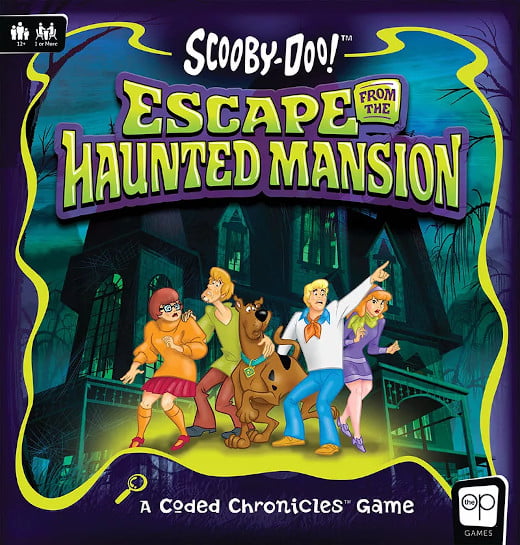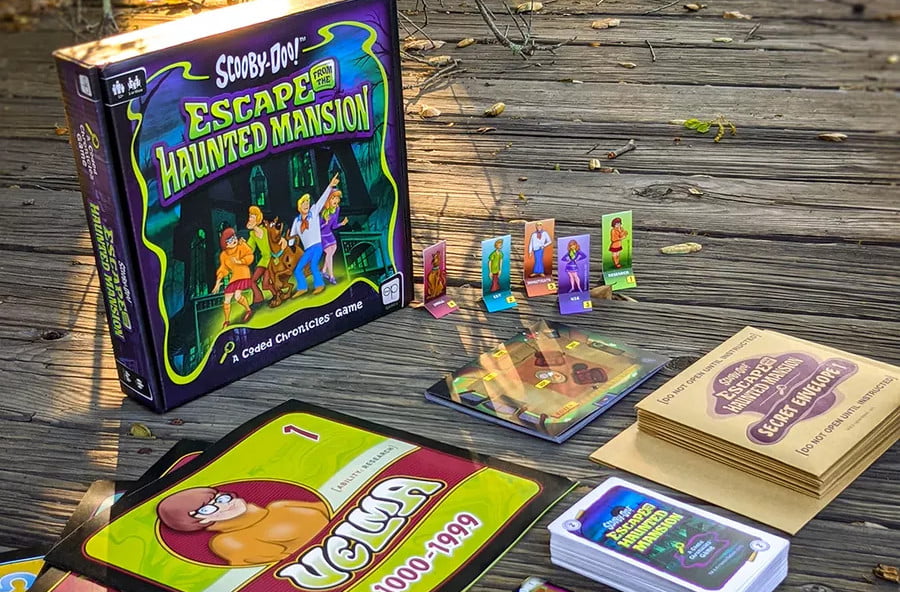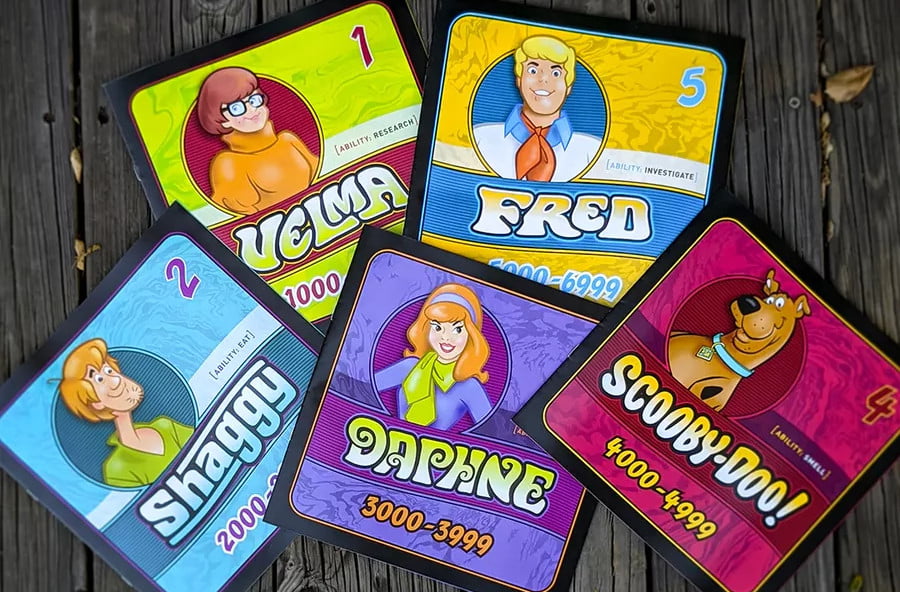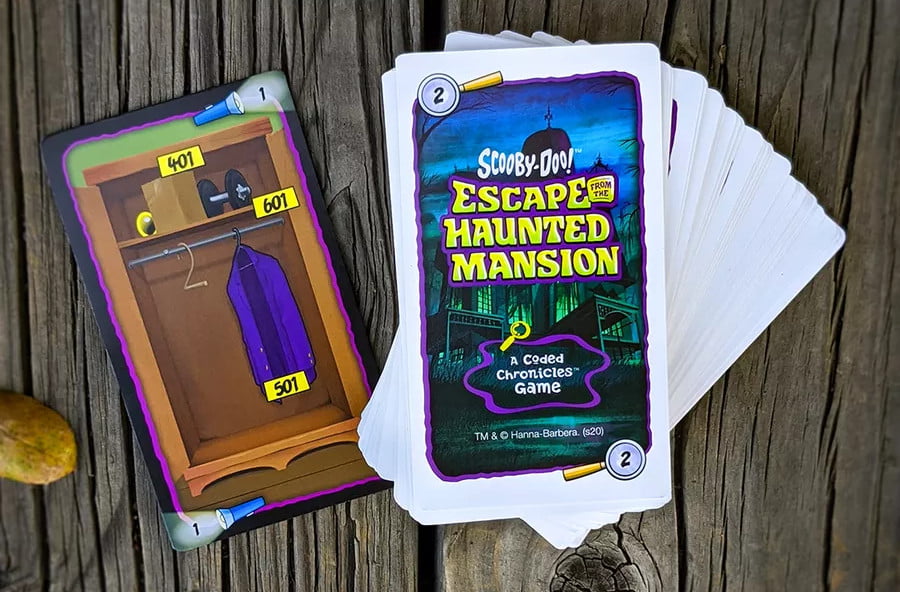Scooby Doo was never my favourite franchise growing up. I always thought it looked hokey, all the monsters were disappointing because they didn’t tend to make sense and were always just dudes in suits, and there were always so many episodes of it so that any time you were watching cartoons it’s possible a slot that something interesting could be in would be surprisingly filled by Some More Scooby Doo. As I grew up, there was always more Scooby Doo stuff, almost as if it was just a franchise running in the spot while the timeline of the background spooled in a circle behind it.
I have never perceived Scooby Doo branding as a sign of quality.
Let me then explain to you the surprise and delight that came out of playing this game and finding out that it is a genuinely fascinating, clever board game experience that I thoroughly enjoyed.
Scooby-Doo Escape From the Haunted Mansion, a title I will be endeavouring to avoid repeating because it’s a pain to type out in full like that and I stylistically tend to try and repeat names when I write about things, is a board game for one or more players where you take on roles of the Scooby Gang who’ve been stranded in a mansion together.
The game, mechanically, plays out like a sort of choose-your-own adventure story, where each character has a booklet, and at certain points you’ll have more or fewer booklets. Velma can investigate things, Shaggy can eat things, Scooby can smell things, that kind of thing, and each room is decorated with numbers so you can act on them. This means that every object you can investigate, you probably can also try to eat it, or try to smell it, and the different characters get different results from things.
This isn’t an endlessly repeatable experience, mind you: Because these booklets have specific responses to solving puzzles as you progress through the game, you’re only getting one path through the whole game. The game even has two break points in it, where it recommends you stop playing for a bit, because you’ve probably played for a bit, and then you can come back and solve the puzzles and continue the game. It’s like a legacy game, with this very sculpted experience. As you progress through the puzzles, moving around the mansion, you’ll get told to open envelopes, add cards to a deck, or remove them from a deck.
Also, this game is for kids.
Like, this game is for eight year olds.
Legacy board games are pretty popular these days, with all sorts of big-box efforts that present themselves as prestige experiences that you play through to reach the end of their story, and then… that’s it. You’re left with this wonderful momento of what you played, but the play experience of it is usually somehow lost at that point. Given that board games are not an environmentally impact-free experience, especially those that rely on plastics, there’s a bit of me that recoils at the idea of a board game that’s treated as a limited experience, with components that can’t be passed on or put to another use at the end of their functional life.
Basically, I’m always a little leery of how much waste can be involved in these games. And in Escape From The Haunted Mansion, you probably only play it through once, right, which makes it seem even more wasteful, even if the impact is minor in a grand scale.
… well, it seems the people who made this have similar anxious frets to me. Every single thing I could find in this game box is made out of recycleable paper or cardboard, with a few plastic stickers that are, themselves, recycleable and aren’t essential to the game experience. When you’re done with this game, you can put all the pieces back in the same envelopes they came from, and put it back in the box and give it to someone else and they get the exact same experience you did.
It’s a fundamentally non-destructive recycleable legacy board game experience. And it’s about Scooby Doo!
I’ve talked about how some cooperative experiences are impossible to truly talk about, because it’s about the connections with the people you played it with. As good as this game may or may not be, there will never be a fair opinion of it from me, because I will always connect it to that moment when my nibling slammed two cards together, and pointed at them dramatically, going audibly, “awhoohhhhhh!!!” like they’d worked something out.
They weren’t even right!
It didn’t matter!
What mattered was that we were completely in that moment, together; yes, I, as an adult, was trying to make sure that the experience wasn’t confusing, that we didn’t commit to mistakes, or lose the game (though we had a fairly forgiving experience on that front). What mattered was that the game was something where my nibling felt engaged with it, on its level, and so did I.
I love my family, which means, okay, that’s not going to be a surprise that I like playing games with them. But this game in particular wanted to put them and me in the same mental space of ‘solving puzzles’ and for those puzzles to be things both of us could handle. That’s impressive. That’s remarkably difficult, too, and the interface didn’t overwhelm him or bore me.
I think the older I get the more I like Scooby Doo. The more I like a vision of the world where the point of the mysterious is to understand and solve it. Where ghosts and ghouls aren’t as likely as selfish people who want to take advantage of you for money. Where you’d rather a talking dog than the help of the typically unhelpful cops.
I really liked this game, and almost every place I started to find fault, I realised, they had thought of my complaint ahead of time. That’s a pretty impressive lift for a board game that’s designed to trade off a classic kid’s cartoon.
All images are from BoardGameGeek




1 Trackback